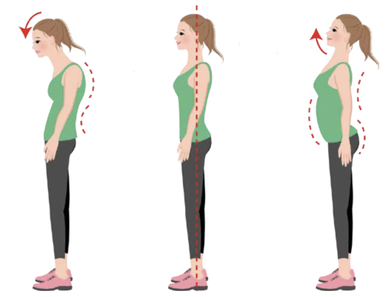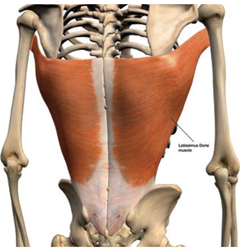Do you find your neck and back aching, or feel pain or tingling in your arms or hands? Are these problems worsened by endless time on your computer or phone − head craned forward as you type and scan? Maybe you’ve wondered if your posture is correct.Rounded shoulders are part of overall bad posture, and they can get worse if left untreated, affecting your entire body and wellbeing. Unfortunately they’re common in our tech-driven, sedentary modern lives.
As your neck bends forward and your shoulder blades wing out and your shoulders slump − other problems arise. Your elbows bend, your wrists twist forward, and your thumbs flex. Your back is also affected; extra pressure is put on your spine and trunk muscles, triggering muscle and joint pain and headache. Even your ability to breathe correctly can be reduced. HOW CAN YOU TELL IF YOU HAVE ROUNDED SHOULDERS? Ask someone to take some photos of you while standing naturally. Look at your posture from the side. If your earhole sits forward from your shoulder, that’s a yes. If your shoulders and spine at the middle of your back round forward, that’s a yes. If your knuckles face forward, that’s a yes too. WHAT CAN YOU DO TO REVERSE THIS CONDITION? There are a range of steps. If you have a sedentary job, ensure your workstation is set-up correctly. Use a lumbar support. Set the top of your monitor to sit at your eye line. Ensure your knees, hips, and elbows maintain a 90-degree angle. Remember, take regular breaks. Stretching your chest muscles and strengthening your core may also help. There are many ways to do this so it’s best to get professional advice, but here’s a quick practice you can do any time. Stand straight. Pull your belly button slightly upward and back towards your spine. Hold for 10 seconds. Repeat three times. We can advise you on a workstation set-up, help assess and correct rounded shoulders, and recommend stretches and strengthening exercises that are best for your body.
0 Comments
The greatest weapon against stress is our ability to choose one thought over another - William JamesHas COVID-19 taken a toll on your mental health? Do you feel sad or anxious, or worry about the future? Have changes in your work, social life, or finances caused you stress? You’re not alone. A recent study by the Black Dog Institute found that just over three quarters of Australians surveyed felt their mental health had worsened since the pandemic began. But there is good news. There are simple steps that can bring joy back into your life.
Firstly, remember to be kind to yourself. These times are unprecedented and there’s no rule book. Listen to what your body and mind need. Take time to rest and get sufficient sleep. Dedicate moments to simple pleasures and delight in your favourite hobbies. Move often. Catch the sun and bathe in nature. Enjoy long and short walks. Hit the gym for a healthy dose of happy hormones. Swim at the beach or in your local pool. Take yoga, Pilates, or Tai Chi classes − join a group or try online tutorials. A focus on your fitness will also help to lower the risk of physical pain that often rears its head when under stress. Eat well. Nutrition nourishes your brain. Choose a rainbow diet, one filled with a variety of colours. This provides the vitamins, minerals, and fats needed for brain function and mental wellbeing. But don’t be rigid or harsh; savour that piece of chocolate cake! Engage the 80/20 rule − eat well 80% of the time − remember food can, and should be, therapeutic and delicious. Reduce your stress. Ongoing tension wears us down. This past couple of years has provided little respite. One negative event has followed another. Even when we’re not fully aware of it, harmful stress can exist. So... Catch up with loved ones and plan regular social catch-ups; whether it’s in-person or online, keeping in contact with people is very important for your mental health. Keep a daily journal. Practice slow, deep and rhythmic breathing. Be mindful, fully in the present moment. Meditate, dance, sing, bake, cuddle animals, volunteer. Read an inspiring book. Watch the sun rise or set. Plan and take a holiday. Find those things that bring you calm and schedule them, regularly. There is much you can do to protect your mental health and find joy, but if you need expert help, reach out. We can put you in touch with the right health professional. Whether in pancakes, yoghurt, muffins or jam, blueberries are an amazing fruit, absolutely bursting with goodness.Blueberries are native to North America but are now grown around the world, including Australia. They grow from shrubs; the farmed ‘highbush’ varieties produce the larger fruits that you find in shops, but wild ‘lowbush’ shrubs tend to have smaller, more nutrient-rich berries.
Blueberries have long been known as a ‘superfood’ due to their high levels of nutrients and antioxidants, but what are the real benefits of including them in your diet? As they are relatively low in sugar and high in fibre they have a low glycaemic Index, which makes them a source of slow-release energy – good for maintaining steady blood sugar levels, and great for gut health. Blueberries contain high quantities of Vitamin C and Vitamin K. Vitamin C is important for skin health and immune function, and Vitamin K is mostly involved in blood clotting. They also have vitamins A, B, and E, and a range of minerals. They’re also rich in antioxidants, the molecules that fight harmful free radicals in your body. Free radicals occur naturally in your body, but high levels have been linked to cancer, heart disease and diabetes. Eating food with high levels of antioxidants helps your body maintain that all important healthy balance. One group of antioxidants in blueberries is known as anthocyanins – these give blueberries and similar berries their natural blue colouring. Anthocyanins have been linked to all sorts of benefits, such as improved cognition and memory, as well as reducing cardiovascular disease and diabetes. Some studies have shown that eating blueberries regularly can have an anti-inflammatory effect. This can protect your brain cells, improve blood flow and reduce blood pressure. Alongside all these health benefits, they’re a delicious and versatile fruit. They last well when fresh, and can be flash-frozen to retain many of their nutrients – you can find them fresh or frozen in most supermarkets. This means it’s easier than ever to throw some in your next smoothie or on top of your porridge, and enjoy the fruity boost of a truly healthy food. Have you heard of the muscle, the latissimus dorsi? It’s often referred to as the ‘lats’. Exercises and gym equipment designed to maximise its bulk and streamline its V-shape are popular, but its role is far more than just looking good.Latissimus refers to broad and dorsi to the back. So, this Latin term simply means the broadest muscle of the back. And broad it is! This large reversed triangle attaches to a number of places in the upper and lower body. So, it plays an important role in connecting your top and bottom halves.
WHERE IS THE LATISSIMUS DORSI? It emerges from just below the midsection of your middle back to your sacrum, or tailbone. Place your hands on your hips. The curved bones below your thumbs are called your iliac crests — it attaches here on both sides, too. Rising from your lower ribs, it connects to the tips of each shoulder blade, then winds its way under the inside of your upper arm (humerus) around to the front. It’s amazing really, that a single muscle can bridge the lower and mid back, and anchor near your shoulders. No wonder part of its name means broad! WHAT DOES IT DO? A muscle’s function is to contract or shorten − to tighten, or relax − to lengthen. This is how your muscles move the body part or parts they’re attached to. Think about one of your quadriceps while you sit. As you contract this muscle, it shortens and straightens your knee. As it relaxes, your knee bends. Your latissimus dorsi works in the same way, only it moves different bones. At your shoulder, the latissimus dorsi draws your humerus backward, toward the side of your body, and twists inward. It also pulls the bottom tip of your shoulder blade down and towards your spine, which draws your shoulders down and back. This is great for your posture! But your lats is not only a shoulder-movement muscle; it does more than this... Research suggests that the latissimus dorsi contracts when we lean to the side, twist around, or flex and extend the spine, bending forwards or straightening up. This indicates that it’s important in stabilising and supporting our spine as it moves. Healthy, strong lats, then, could help to prevent back and pelvis problems. In fact, one 2013 study showed that strengthening this muscle helps to relieve pain in the area where the middle and lower back meet. There are various exercises and activities − like swimming and rowing − to strengthen the lats. Remember, because all muscles contract and relax, they can become tight too. Stretches can help release tension. If you have concerns or questions about your latissimus dorsi, ask us − we can also recommend the best exercises, activities and stretches for your body. |
AuthorAdam's Back is a team of dedicated complimentary health professionals. Our aim is to support you in finding drug-free solutions for better health. Archives
July 2024
Categories |
Search by typing & pressing enter





 RSS Feed
RSS Feed